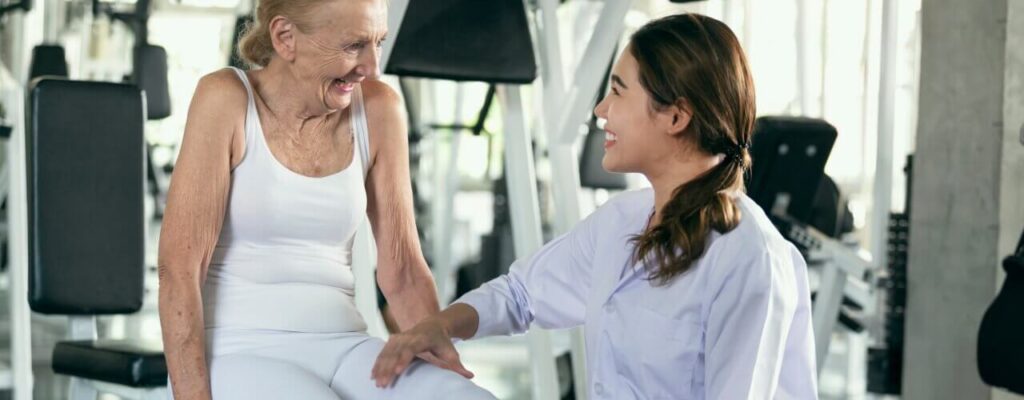Using Physical Therapy to Treat Incontinence

A physical therapist is an expert in evaluating and treating musculoskeletal and neurological conditions with the help of physical therapy that affect the body.
This profession focuses on identifying any underlying factors that may be contributing to impaired functional mobility, activity, participation, and quality of life, such as strength, neuromuscular control, balance, coordination, skeletal alignment, and endurance.
Of course, most people seek physical therapy only when they have a common injury or condition, such as whiplash, tendinitis, low back pain, or ligament sprains. Perhaps less well known is that physical therapy can help with chronic pelvic pain and dysfunction, particularly issues with incontinence.
Is incontinence affecting your life? Contact Beyond Physical Therapy today to uncover your treatment options. We can help you recover and prevent further issues from occurring, so you can return to the lifestyle you love.
What is incontinence?
Urinary incontinence has a reputation for being a condition that only the elderly suffer from. However, many young people suffer from urinary incontinence.
Urinary incontinence affects more women than men; however, it is common for men to experience it after certain procedures, such as prostate surgery. Fortunately, there are numerous treatments available for urinary incontinence.
Stress incontinence and urge incontinence are the two main types of incontinence. Stress incontinence occurs when a urine leak occurs as a result of pressure on the bladder.
Exercise, lifting heavy objects, laughing, coughing, or sneezing, for example, can all cause stress incontinence. This is the most common type of bladder control issue in younger to middle-aged women, and it can occur around menopause.
Urge incontinence occurs when there is an urgent need to urinate. Someone suffering from urge incontinence may not have enough time to reach the toilet before leaking occurs. Diabetes, Alzheimer’s disease, Parkinson’s disease, multiple sclerosis, or stroke are common causes of bladder control issues.
Common conditions that may cause urinary incontinence include:
- Pregnancy.
- Menopause.
- Weak bladder muscles
- Overactive bladder muscles
- Damaged bladder nerves, typically from diseases such as diabetes, multiple sclerosis, or Parkinson’s
- Blockage from an enlarged prostate
- Difficulty getting to the bathroom in time, due to diseases such as arthritis
- Damaged pelvic floor nerves, due to injury or surgery
- Pelvic organ prolapse
- Prostatitis
- Benign prostate hyperplasia
How can I treat urinary incontinence?
Simple lifestyle changes may provide relief for some people suffering from urinary incontinence. If you have stress incontinence and leak urine when you cough, sneeze, or laugh, your physical therapist may advise you to drink less.
If you have urge incontinence, which means you have an urgent need to urinate but can’t always get to the bathroom in time, your physical therapist may advise you to avoid spicy foods, caffeine, and carbonated drinks because they can irritate the bladder and worsen the problem.
Kegel exercises, which strengthen the pelvic floor muscles, can sometimes help people who suffer from incontinence. Kegels are used in conjunction with biofeedback techniques to determine whether the exercises are being performed correctly.
Bladder retraining can also help with urge incontinence. This entails gradually increasing the time between bathroom trips, working up to longer and longer intervals between bathroom stops.
Other common incontinence treatments include, but are not limited to:
- Additional pelvic floor strengthening exercises.
- Urge suppression strategies.
- Education.
- Electrical stimulation.
- Hip and core strengthening.
Absorbent products and devices
Protective pads and pantyliners can assist in avoiding embarrassing situations. A “pessary,” a plastic device inserted into the vagina, may help prevent urine leakage by supporting the bladder’s neck. This is especially helpful for stress incontinence.
Behavioral or exercise therapy can greatly improve or even cure mild to moderate cases of common types of incontinence. We can also teach you habits and techniques for dealing with stress. Even occasional incontinence does not have to be something you have to live with – we can help!
Contact Beyond Physical Therapy for Relief!
We understand that living with urinary incontinence can be limiting – and even embarrassing at times, especially when it occurs in public. Our licensed physical therapists are committed to improving your pelvic health, quality of life, and socialization so you can live your best life.
When you come in for your initial consultation, one of our physical therapists will examine you to determine the strength of your pelvic floor. Your physical exam, as well as an evaluation of your medical history and a discussion of your symptoms, will aid in determining the best course of treatment for you.
If you are experiencing urinary incontinence and would like to schedule an appointment, please contact us today. One of our Franklin physical therapists will start you on the road to urinary control and relief!
